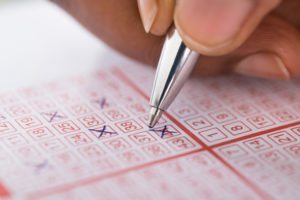
Playing lotteries in an attempt to win hefty sums has been almost ingrained into human nature for several centuries.
The world’s first known official lottery was arranged in 1567 by English Queen Elizabeth I. At that time England was seeking to expand its worldwide export markets. The lottery was intended to raise money for the enormous costs of building ships and developing ports. Since then, for nearly six centuries, the general principle of a lottery has largely remained the same – a random draw from an urn of objects bearing predefined symbols with established prizes for players who made correct predictions according to predefined rules. Presently, the results of most lottery draws worldwide are published online, even as regional as North Carolina in the US, such as NC pick 3.
The objects can be balls, tickets, lots, plates, etc, but for analyzing best winning strategies it does not matter. For mathematical game theory, both the design and the psychological aspects of lottery are irrelevant. Many lottery players have superstitions, personal preferences and beliefs which mathematics does not quantify. For example, many lottery players avoid playing certain sequences, such as 1, 2, 3, 4 or 10, 20, 30, 40, believing that they are less likely to be drawn than the “regular” sequences. But for the mathematical lottery model they have the same occurrence probability as any other sequence. The same applies to choosing numbers that have some significance for the players, such as their birthday dates.
It has been observed that from all games of chance, lottery offers the lowest winning odds for the top prizes, despite its enduring popularity. Because of that analyzing the lottery winning odds through robust mathematical model, particularly game theory, is important. It’s well-known that casinos and other gambling establishments design games in such a way as to always make a profit.
According to popular comparison, winning a lottery is less likely than being struck by lightning. One way or another, even the most complex mathematical models on average boil down to one thing: if you bet 1 dollar, and you are offered to win 1,000 dollars, then your chance of winning is less than 1/1,000. Game theory evaluates any strategy similarly – the probability of winning is multiplied by its size.
This principle allows you to roughly compare different games with each other. Which is better: a million dollars with a 1/100,000 chance or 50 dollars with a 1/4 chance? Intuitively, the former looks more interesting, but the latter is mathematically more sound. However, people play not only because of hefty jackpot alone, but also because of emotions from the process, and even more so from winning. Moreover, money is non-linear for us: formally, getting 1 dollar right now is like getting a million dollars with a chance of 1/1,000,000, but in fact, the loss of a dollar will not affect our condition in any way, absolutely nothing will change in life, but winning a million is a watershed event.
In present times there are two major types of lottery to consider. In the US, the ticket either contains a sequence of numbers, or it is chosen by the buyer. Elsewhere another lottery format is preferred: there are several lines of numbers on the ticket, and you need to guess either one of them (a regular win) or all of them (jackpot). In theory, a lottery company can purposefully print and sell non-winning tickets, and then manipulate the order of the balls, but in practice, large companies do not do this: the organizers of the lottery make huge profits anyway, and the scandal in case of uncovering such behavior would be huge. All in all, if you want to gamble, it would be better to understand gambling principles and make sure that there is no influence of interested parties on the results.
Read more:
CHASING LADY LUCK: WINNING A LOTTERY






